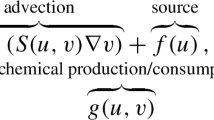Abstract
The kinematics of helical motion are descirbed for an organism treated as a rigid body with six degrees of freedom relative to the organism's frame of reference, i.e. the organism can translate in the direction of, or rotate around any of, three orthogonal axes fixed to its body. Equations are derived that express the unit vectors of the Frenet trihedron and the torsion and curvature of the trajectory in terms of the organism's translational and rotational velocities. These equations permit description of the radius, pitch, angular velocity and axis of a helical trajectory in terms of the translational and rotational velocities of the organism swimming along that trajectory. The results of this analysis are then used in two later papers that describe how organisms can orient to an external stimulus.
Similar content being viewed by others
Literature
Berg, H. C. 1975. Chemotaxis in bacteria.A. Rev. Biophys. Bioengng 4, 119–136.
Brokaw, C. J. 1957. “Electro-chemical” orientation of bracken spermatozoids.Nature 179, 525.
Brokaw, C. J. 1958a. Chemotaxis of bracken spermatozoids. Ph.D. thesis. Cambridge University, Cambridge, U.K.
Brokaw, C. J. 1958b. Chemotaxis of bracken spermatozoids: Implications of electrochemical orientation.J. exp. Biol. 35, 197–212.
Brokaw, C. J. 1959. Random and oriented movements of bracken spermatozoids.J. cell. comp. Physiol. 54, 95–101.
Brokaw, C. J. 1974. Calcium and flagellar response during the chemotaxis of bracken spermatozoids.J. cell. Physiol. 83, 151–158.
Bullington, W. E. 1925. A study of spiral movement in the ciliate infusoria.Arch. Protistenk. 50, 219–275.
Chwang, A. T. and T. Y. Wu. 1971. A note on the helical movement of micro-organisms.Proc. R. Soc. Lond. Ser. B 178, 327–346.
crenshaw, H. C. 1989. Kinematics of helical motion of microorganisms capable of motion with four degrees of freedom.Biophys. J. 56, 1029–1035. (Note correction inBiophys. J. 57, 1109).
Crenshaw, H. C. 1990. Helical orientation: A novel mechanism for the orientation of microorganisms.Lect. Notes Biomath. 89, 361–386.
Crenshaw, H. C. 1993. Orientation by helical motion—III. Microorganisms can orient to stimuli by changing the direction of their rotational velocity.Bull. math. Biol. 55, 231–255.
Crenshaw, H. C. and L. Edelstein-Keshet. 1993. Orientation by helical motion—II. Changing the direction of the axis of motion.Bull. math. Biol. 55, 213–230.
Diehn, B. 1973. Phototaxis and sensory transduction inEuglena. Science 181, 1009–1015.
Fenchel, T. and P. R. Jonsson. 1988. The functional biology ofStrombidium sulcatum, a marine oligotrich ciliate (Ciliophora, Oligotrichina).Mar. Ecol. Prog. Ser. 48, 1–15.
Foster, K. W. and R. D. Smyth. 1980. Light antennas in phototactic algae.Microbiol. Rev. 44, 572–630.
Gillett, P. 1984.Calculus and Analytic Geometry, 2nd edn, 915 pp. Lexington, MA: D.C. Heath.
Goetz, A. 1970.Introduction to Differential Geometry, 350 pp. Reading, MA: Addison-Wesley.
Gray, J. 1955. The movement of sea-urchin spermatozoa.J. exp. Biol. 32, 775–801.
Jennings, H. S. 1901. On the significance of the spiral swimming of organisms.Am. Nat. 35, 369–378.
Jennings, H. S. 1904.Contributions to the Study of the Behavior of Lower Organisms. Carnegie Institute of Washington Publication No. 16.
Kamiya, R. and G. B. Witman. 1984. Submicromolar levels of calcium control the balance of beating between the two flagella in demembranated models ofChlamydomonas.J. Cell Biol. 98, 97–107.
Keller, J. B. and S. I. Rubinow. 1976. Swimming of flagellated microorganisms.Biophys. J. 16, 151–170.
Ludwig, W. 1929. Untersuchungen über die schraubenbahnen niederer organismen.Z. vergl. Physiol. 9, 734–801.
Naitoh, Y. and K. Sugino. 1984. Ciliary movement and its control inParamecium.J. Protozool. 31, 31–40.
Purcell, E. M. 1977. Life at low Reynolds number.Am. J. Physics. 45, 3–11.
Rüffer, U. and W. Nultsch. 1985. High-speed cinematographic analysis of the movement of Chlamydomonas.Cell Motil. 5, 251–263.
Schaeffer, A. A. 1920.Ameboid Movement, 156 pp. Princeton, NJ: Princeton University Press.
Sugino, K. and Y. Naitoh. 1988. Estimation of ciliary activity inParamecium from its swimming path.Seitai Nō Kagaku 39(5), 485–490.
Symon, K. R. 1971.Mechanics, 3rd edn, 639 pp. Reading, MA: Addison-Wesley.
van Houten, J. and R. R. Preston. 1988. Chemokinesis. InParamecium, H. D. Görtz (Ed.), pp. 282–300, New York, NY: Springer-Verlag.
Author information
Authors and Affiliations
Rights and permissions
About this article
Cite this article
Crenshaw, H.C. Orientation by helical motion—I. Kinematics of the helical motion of organisms with up to six degrees of freedom. Bltn Mathcal Biology 55, 197–212 (1993). https://doi.org/10.1007/BF02460302
Received:
Revised:
Issue Date:
DOI: https://doi.org/10.1007/BF02460302




